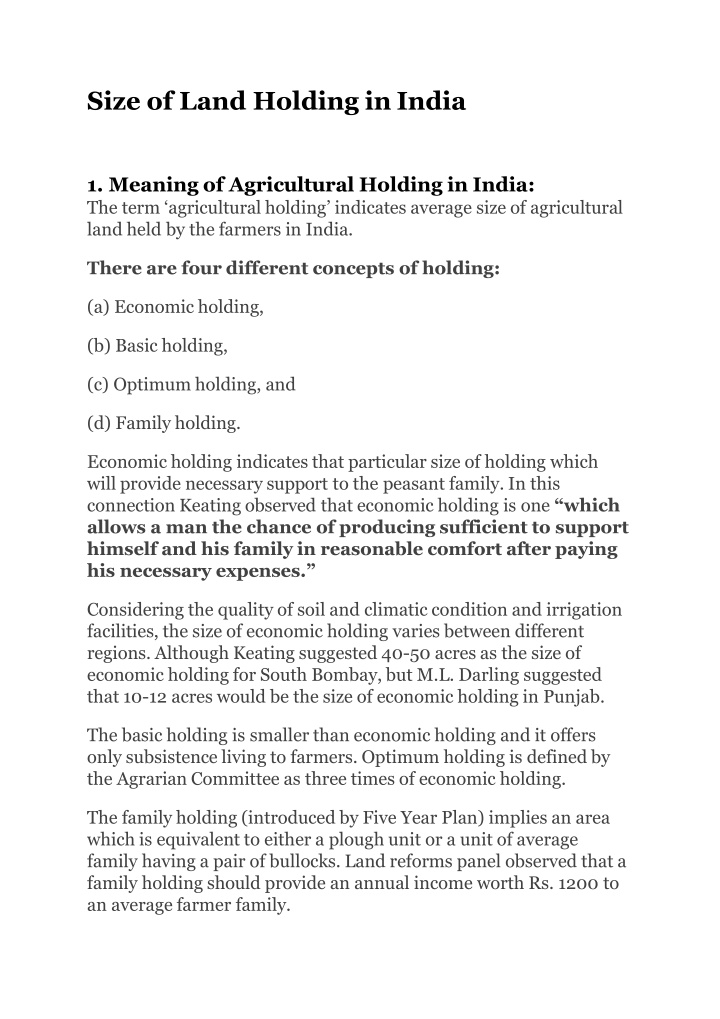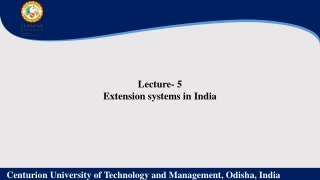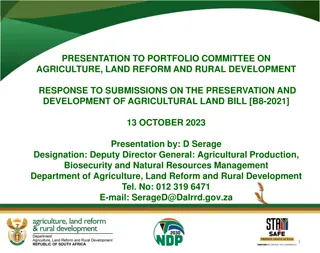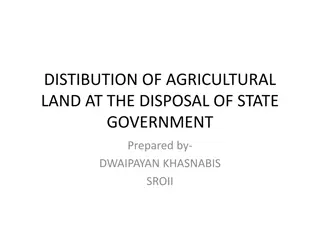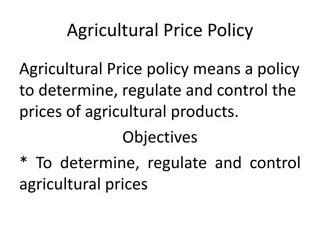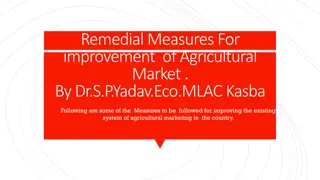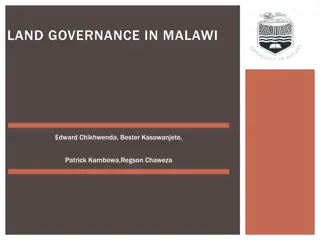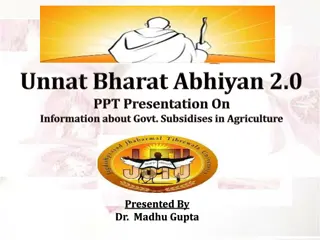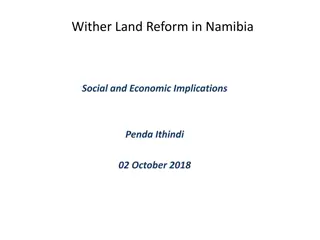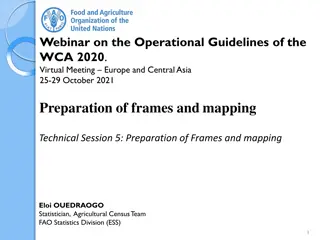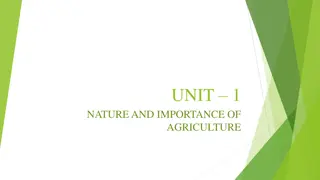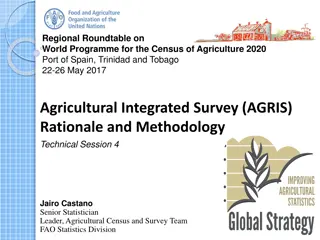Agricultural Land Holdings in India: Trends and Implications
The average size of agricultural holdings in India is declining, with a significant portion falling under uneconomic categories. Different concepts of holdings such as economic, basic, optimum, and family holdings play a key role in determining the livelihood of farmers. The fragmentation and small size of holdings pose challenges for Indian agriculture, affecting farmers' income and sustainability. Various studies and census data shed light on the evolving landscape of agricultural land holdings in the country over the years.
Download Presentation

Please find below an Image/Link to download the presentation.
The content on the website is provided AS IS for your information and personal use only. It may not be sold, licensed, or shared on other websites without obtaining consent from the author.If you encounter any issues during the download, it is possible that the publisher has removed the file from their server.
You are allowed to download the files provided on this website for personal or commercial use, subject to the condition that they are used lawfully. All files are the property of their respective owners.
The content on the website is provided AS IS for your information and personal use only. It may not be sold, licensed, or shared on other websites without obtaining consent from the author.
E N D
Presentation Transcript
Size of Land Holding in India 1. Meaning of Agricultural Holding in India: The term agricultural holding indicates average size of agricultural land held by the farmers in India. There are four different concepts of holding: (a) Economic holding, (b) Basic holding, (c) Optimum holding, and (d) Family holding. Economic holding indicates that particular size of holding which will provide necessary support to the peasant family. In this connection Keating observed that economic holding is one which allows a man the chance of producing sufficient to support himself and his family in reasonable comfort after paying his necessary expenses. Considering the quality of soil and climatic condition and irrigation facilities, the size of economic holding varies between different regions. Although Keating suggested 40-50 acres as the size of economic holding for South Bombay, but M.L. Darling suggested that 10-12 acres would be the size of economic holding in Punjab. The basic holding is smaller than economic holding and it offers only subsistence living to farmers. Optimum holding is defined by the Agrarian Committee as three times of economic holding. The family holding (introduced by Five Year Plan) implies an area which is equivalent to either a plough unit or a unit of average family having a pair of bullocks. Land reforms panel observed that a family holding should provide an annual income worth Rs. 1200 to an average farmer family.
2. Size of Agricultural Holding in India: In India, the size of agricultural holding is quite uneconomic, small and fragmented. N.J. Kurien observed that the estimated average size of holding in India is expected to decline from 1.5 hectares in 1990-91 to 1.3 hectares in 2000-01. The marginal holdings are normally expected to be 59.7 per cent in 1990-91 which are expected to rise further to 62.1 per cent in 2000-01. Table 7.5 shows the size and number of operational holding and area operated upon by these various sizes. Table 7.5 given above reveals that out of the total number of 97.8 million holding in 1985-86, 58.1 per cent was of marginal category, and the remaining category of holding include small category 18.3 per cent, semi-medium 13.6 per cent, medium 8.1 per cent and large 2.0 per cent. If we take those holding less than one hectare as uneconomic then the table shows that about 58.1 per cent of holding can be considered as uneconomic and the remaining 41.9 per cent of the total holding are economic. The total area operated under uneconomic holding was to the extent of 21, 6 million hectares) which was about 13.2 per cent of the total area operated (163.9 million hectares). The table further shows that the average size of holding in India is very small. In 1985-86 the average size was only 1.7 hectares. Due to continuous subdivision and fragmentation of holdings, average area operated per holding has been declining gradually in the country.
In the mean time, a number of agricultural censuses of operational holdings have been conducted in India during the period ranging from 1970-71 to 1990-91. In these censuses operational holdings have been studied as distinct from ownership holdings. Table 7.6 shows the changes in number and area of operational holdings in India during the aforesaid period. Table 7.6 reveals that the total number of holdings in India has increased from 71 million in 1970-71 to 106 in 1990-91 showing an increase of 48 per cent. But the total area of such holdings has increased marginally from 162 million hectares in 1970-71 to 166 million hectares in 1990-91. Total number of marginal holdings has increased from 36 million in 1970-71 to 62 million in 1990-91 (i.e. 58 per cent of the total holdings) and the area operated by this category was 25 million hectares. Total number of small holdings (ranging between 1 to 4 hectares) has also increased from 24 million in 1970-71 to 34 millions in 1990- 91 (i.e. 33 per cent of the total holdings) and the total area operated by this category has also increased from 49 million hectares in 1970-71 to 67 million hectares in 1990-91, which was about 41 per cent of the total area. Again the total number of medium holdings, in the range of 4 to 10 hectares has remained the same at 8 millions both during 1970-71 and 1990-91 but in percentage of total holdings the figure declined from 11 per cent in 1970-71 to 7 per cent in 1990-91. Total area operated under this category of holding has declined from 48 million in 1970-71 to 45 million in 1990-91 and theirshare
in percentage of total area has also declined from 30 per cent to 27 per cent during the same period. Moreover, the total number of large holdings in the range 10 hectares and above has also declined from 3 million in 1970-71 to 2 million in 1990-91 and their share in percentage to total holdings has also declined from 4 per cent to 1 per cent during the same period. Total area operated under this category has also declined substantially from 50 million hectares in 1970-71 to 29 million hectares in 1990-91 and their share in percentage terms has also declined from 31 per cent to 17 per cent during the same period. Size of operational holdings has thus been declining year by year leading to increase in the number of marginal and small holdings and fall in the number of medium and large holdings. All these has resulted continuous sub-division and fragmentation of land holdings in the country. 3. Causes of Sub-Division and Fragmentation of Agricultural Holding: With the growth of the size of families, the agricultural holdings in India are gradually being sub-divided among the heirs on the death of the owner of the land. In this way generation after generation the land is being subdivides and fragmented as well. Under such a situation a member of the family gets one tiny plot at one place and another tiny plot at another place leading to a peculiar problem of growing sub-division and fragmentation of holding. The following are some of the important causes of growing sub-division and fragmentation of agricultural holding in India: (i) Increasing Pressure of Population:
With the rapid growth of population, in the country, the pressure of population on land is increasing. In view of near absence of the growth of alternative occupations, people started to put much pressure on agriculture leading to continuous sub- division of land. (ii) Laws of Inheritance: In India, the laws of inheritance made provision for equal share of the ancestral property among the children. Due to the application of this law there is a continuous split in the size of farms with every new generation. (iii) Fall of Joint Family System: Under the system of joint family there was no need to sub-divide the size of agricultural holding. But under the impact of growing industrialisation and urbanisation, the joint family system is breaking up rapidly leading to a sub-division of agricultural holding in the country. (iv) Decline of Village Handicrafts and Industries: Due to destruction of village handicrafts and industries, artisans were forced to discard their ancestral occupations and started to depend on agriculture. This has added the dimension of the problem. (v) Rural Indebtedness: High degree of rural indebtedness is another cause which is supplementing to this problem of sub-division of holding. Unscrupulous village moneylenders are charging exorbitant rate of interest and adopting unfair practices and in the process gradually grab the land of the poor cultivators. In this way a part of a land is passing away into the hands of moneylenders leading to increasing sub-divisions of land holding. (vi) Psychological Attachment of Land: Indians are very much psychologically attached to land and they are not mentally prepared to accept payment in lieu of land. The type of mentality has raised the problem of sub-division and fragmentation of agricultural holding.
(vii) Crop Sharing: In India many big land owners lease out their land to tenants instead of cultivating their own. In order to avoid trouble this big land owners deliberately divided the land among the number of tenants and in this way avoid land reform laws. Thus, in this way a large operational holding is deliberately reduced to a number of small uneconomic operational holding. 4. Problems of Sub-Division and Fragmentation of Agricultural Holding: Continuous sub-division and fragmentation of agricultural holding has been resulting in series of problems. These are as follows: (i) Adoption of Modernisation Process Difficult: The growing sub-division and fragmentation of agricultural holding make the adoption of modernized method in agricultural operation quite difficult. Application of new technology, use of fertiliser and making provision for irrigation facilities will be difficult in uneconomic holding. (ii) Wastage of Land: Due to sub-division of holding a good amount of land (about 3 to 5 per cent) is being wasted for drawing boundaries and hedges between huge numbers of tiny plots. In Punjab about 6 per cent of the land is wasted due to this reason. Moreover, due to sub-division the plots become so small that it is quite uneconomic to cultivate such land. (iii) Difficulties in Management: Fragmentation of agricultural holding creates difficulties to the farmers to manage the agricultural operation smoothly. A considerable wastage of time and resources is resulting from transporting agricultural inputs to different fragmented lands.
(iv) Litigation: Small and fragmented farms indulged into frequent boundary disputes. All these quarrels over boundaries result in increasing volume of litigation in the rural areas. (v) Low Productivity: Due to continuous sub-division of holding, the size of land becomes so small that the farmer cannot adopt new techniques of cultivation and instead of they depend on traditional methods. (vi) Disguised Unemployment: Smaller size of holdings cannot provide full time job to all the members of farmer s family. Thus, in the absence of alternative occupations, disguised unemployment started to occur in the rural areas. 5. Remedial Measures to Tackle the Problem of Sub- Division and Fragmentation of Agricultural Holding: Following are some of the important measures advocated for solving the problem of sub-division and fragmentation of land: (i) Economic Holding: To tackle the problem of sub-division and fragmentation, economic holding are to be created. Creation of economic holding requires the following policy: (a)Fixation of ceiling on land holding and distribute the surplus land to those farmers having uneconomic holding; (b)Inducing those farmers having tiny holding to give up their lands and shift them to other occupations; (c)To provide alternative occupations by developing agro-based industries in rural areas.
(ii) Consolidation of Holding: Consolidation of agricultural holding is a solution to remedy the problem of scattered or fragmented holding. Here consolidation of land indicates bringing the scattered small plots of land into a compact block and then divide the compact block among the fanners in a compact manner. In India consolidation was initiated are a voluntary basis and later on it was made compulsory. Majority of the states have already made sufficient provision for the implementation of scheme for consolidation of holdings. But the progress of consolidation is not up to the mark and again is not uniform among all states. In this connection the Sixth Plan mentioned, It is estimated that by now nearly 45 million hectares of land, i.e., about one fourth of the consolidate field has been consolidated all over the country. However, the implementation has been extremely patchy and sporadic. Only in Punjab, Haryana, and Western Uttar Pradesh, the work is complete. Even a beginning has not been made in southern states and Rajasthan. In the Eastern States, some work began only in Orissa and Bihar. Again till 1992, about 61.10 million hectares of land had been consolidated and that constitute nearly 45 per cent of the total cropped area in the country. Thus, the progress of consolidation is not at all satisfactory. Whatever consolidation is achieved that is mostly concentrated in the states like- Maharashtra, Uttar Pradesh, Punjab, Haryana, Madhya Pradesh, Gujarat, Karnataka and Rajasthan. Thus, the factors which are responsible for this failure in respect of consolidation of agricultural holding in India include: (a)Farmers too much attachment to their ancestral land and their unwillingness to surrender for consolidations; (b) Farmer s fear to get inferior blocks after consolidationof holding;
(c)Too much pre-occupation of the state Governments with land reform programmes; (d) Lack of trained staff; (e) Financial stringency faced by the states; (f)Cumbersome and lengthy process followed in consolidation of agricultural holdings; and (g)Lastly, the lack of necessary co-operation from poor and small fanners towards consolidation of holdings. (iii) Co-Operative Farming: Co-operative farming can be considered as a permanent solution towards the problems of sub-division and fragmentation of agricultural holdings in India. Through co-operative fanning, the small and scattered farms can be consolidated in India.
